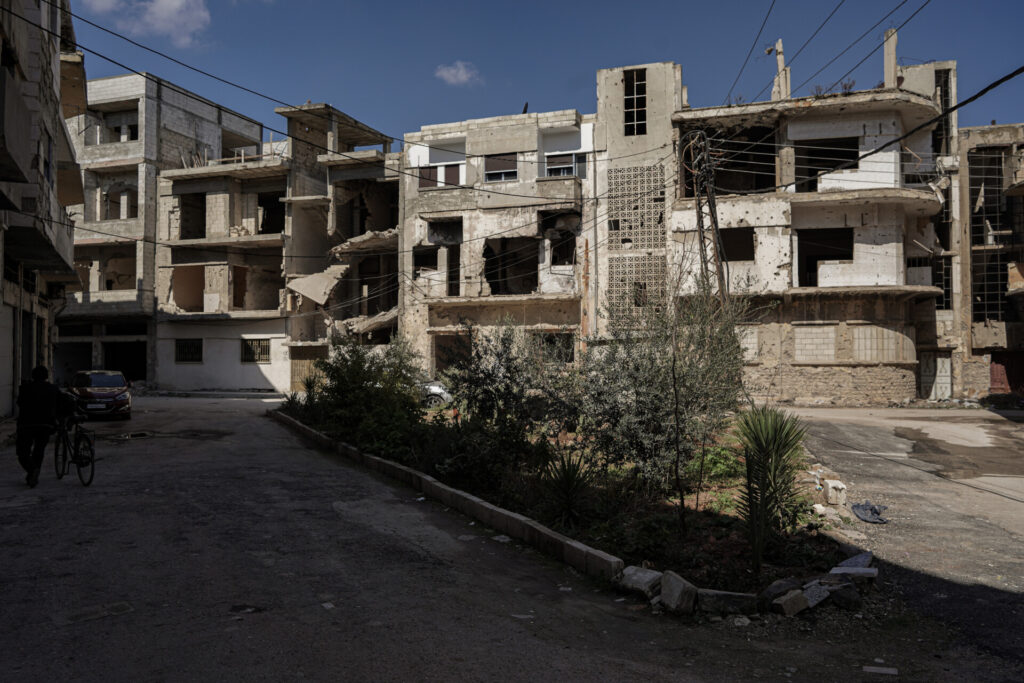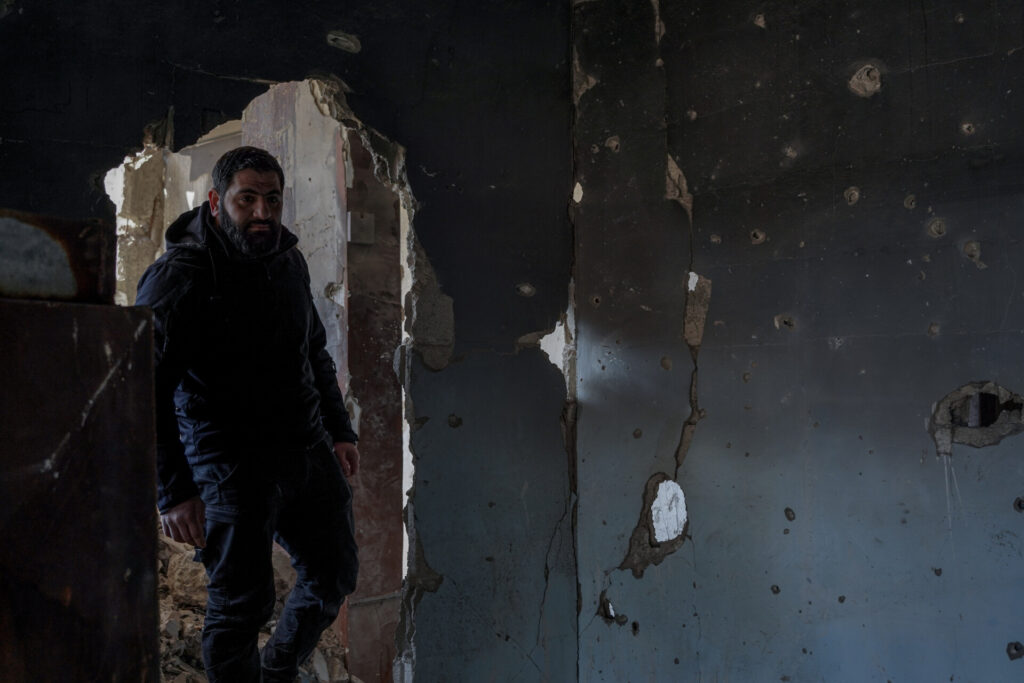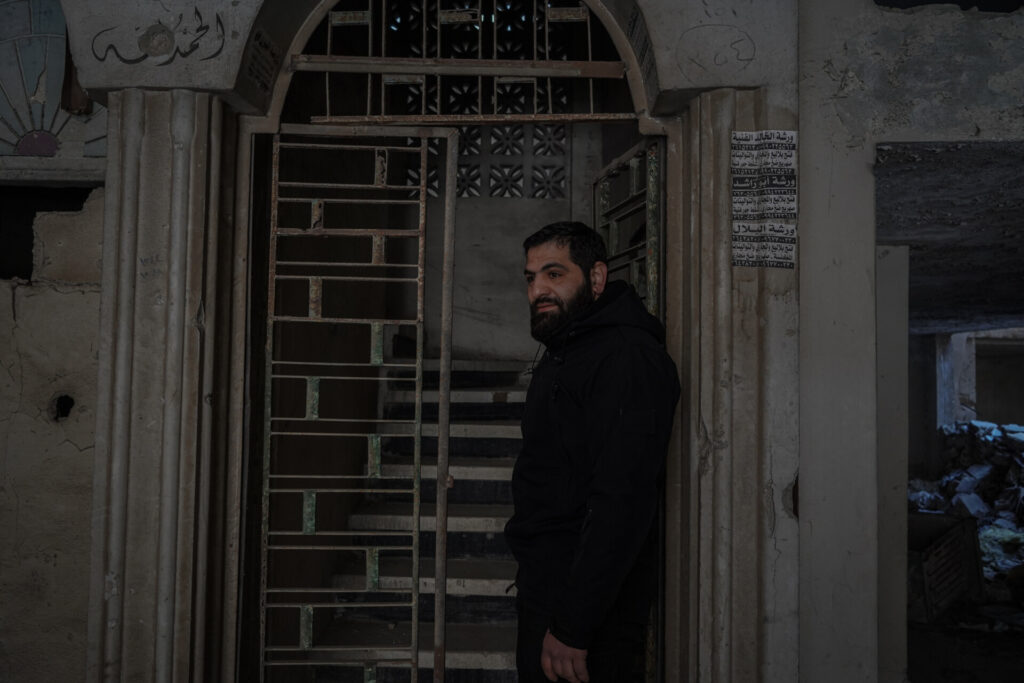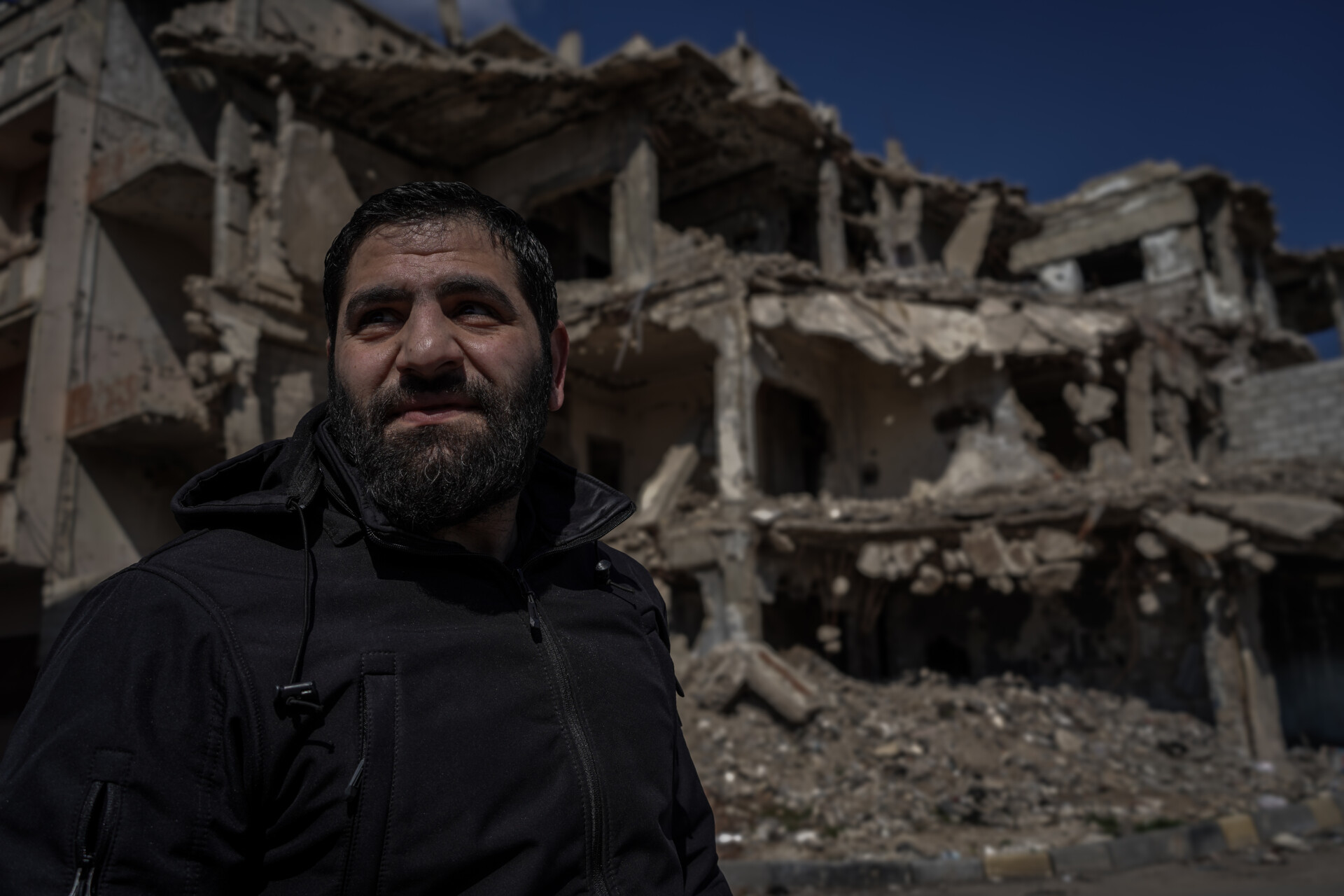“No problem!” Sami al-Agha says on the phone, mid-scene. A second later, two deafening explosions shake the ground. Regime airstrikes. The power goes out. In the darkness, the cameraman moves closer and switches on the flash. Filming continues as if nothing happened, until the electricity returns 90 seconds later. “Ah! The power’s back,” quips the character slouched on the couch.
Sitting in a cafe near Homs’ football stadium on a chilly February afternoon, al-Agha recounts this surreal scene with a casual shrug. The footage appears at the 10-minute mark of the 26th episode of “Mirrors of the Siege of Homs.” “We finished the episode in a pretty laid-back way. We were used to the shelling,” he says. The miniseries, filmed in 2013, was an unlikely creation: a sitcom in the midst of war, using humor to portray the absurd struggles of daily life under siege.
Twelve years later, the stocky man with a scruffy beard still enjoys reposting clips from the show on his Facebook page, followed by nearly 65,000 people. Comedy has always been a passion for him — one of many, alongside sports, particularly weightlifting. At 15, he even won a powerlifting competition.
“I was a hyperactive and reckless kid. They called me the ‘skull-breaker,’” he jokes, gripping a tiny cup of Turkish coffee in his broad hands. That bold nature led him to become a bodyguard for business owners in Damascus’ suburbs when the war broke out in 2011. But just days into the uprising that sparked the war, he witnessed an event that would haunt him.
“One day, the people I worked for rushed into the office with someone. A few minutes later, security forces arrived, claiming he was a terrorist. He was a rebel. They stoned him to death in front of us,” he recalls.
He fled to Jordan, where he took a job at a candy shop that played news channels on a loop. One day, he saw his younger brother on TV, being trampled by regime soldiers. That was his breaking point. He returned to Syria, joined the protests and, soon after, took up arms. In early 2012, the siege of Homs, the capital of the revolution, began.
“After a few weeks of fighting, we ran low on ammunition. We started repurposing unexploded regime shells to make new ones. That gave me the idea for the first episode,” al-Agha recalls.

At the time, he was working with a videographer to create a Homs-centered version of “Spotlight,” a well-known Syrian sketch show. But after two episodes, creative differences ended their collaboration. Determined to continue, he launched “Mirrors of the Siege of Homs” — this time inspired by “Maraya,” another satirical TV show — with the goal of producing 30 episodes for Ramadan.
Teaming up with activist Amr al-Khalidiya, they shot the first season in just 20 days. The project brought together about 15 fighters from Katibat Atbaa al-Rasool, a rebel group. The episodes were filmed directly on the front lines. “We preferred shooting there because it was more convenient for us. There weren’t many civilians, so it was quieter, with more space to let our creativity flow.”
For the fighters, the sitcom became an escape from their grim reality. In his “Pensees,” French philosopher Blaise Pascal describes entertainment as a necessity, something essential to distract people from their miserable and mortal existence. “The only good thing for man, therefore, is to be diverted so that he will stop thinking about his circumstances,” he writes.
During the siege of Homs, these rebels lived in absolute misery, with no certainty of surviving another day. “Mirrors of the Siege of Homs” became a vital distraction, a way to endure the horror of their circumstances.
“When there was nothing left to eat, we survived on cats and weeds. We even tried boiling leather, but it was inedible, so we gave up,” al-Agha laughs. Another trick was grinding radish seeds with Swiss chard, then adding yeast to make a crude, edible dough. “We called it green bread or resilience bread.”
Daily life under siege was bleak. Sami al-Agha worked as a bomb maker, specializing in casting explosive devices. He was part of a three-man team, with the two other rebels handling the chemical compositions while he manufactured the molds. “Every morning, I made munitions in the workshop while thinking about the next episode,” he says. “I’d sketch out a brief storyline, but not the dialogue. The most important thing was having an idea for the intro and outro. Then we’d go film.” In addition to writing the series, he was also its lead actor.

The show’s themes were grounded in reality, drawn from the daily struggles of war. The first episode, “Lamp and Television,” revolved around power shortages. Al-Agha played Wassim, a man who, after six weeks without electricity, begs his neighbor Joe, who owns a generator, for just enough power to run a lamp and a TV. Joe reluctantly agrees, unaware Wassim will immediately plug in his fridge.
A small deception snowballs into a full-fledged black-market operation. Another neighbor, Khaled, asks for power, and Wassim charges him in cigarettes. When demand rises, Wassim orchestrates a fake power outage to drive up prices. Soon, he’s bartering electricity for tobacco, apples and other goods. But Joe grows suspicious, just as his generator dies.
Imbued with a satirical tone, the episode avoids self-pity, focusing instead on dark humor. The harmless neighborhood schemes escalate toward an absurd climax, a comedic revenge of fate against the fragile micro-economy of survival.
The show also mocked the regime. Episode 20 follows a doomed tunnel escape plan. One fighter refuses to dig but later discovers his friend has already started. A week later, the friend hears a deafening noise. Believing it’s an airstrike, he abandons the project. Ironically, the sound came from the other side, where his skeptical friend had begun digging after all.
His tunnel leads straight into a regime-controlled apartment. Trapped behind enemy lines, he improvises, pretending to be a soldier from the “Abu Ali Front.” The regime troops believe him. He even tricks their colonel into handing over money and a pistol before escaping. The episode ends with his mocking monologue: “They were so easy to fool. What a bunch of idiots!”
With over 200,000 views, it remains the most-watched episode, a remarkable success given the team’s limited resources. All they had was al-Khalidiya’s camera, a single computer for editing, a weak internet connection and sheer determination. On average, filming an episode took four hours. The work was both serious and spontaneous. “Sometimes we’d shoot two episodes in one day. If we got an idea, we’d just film it on the spot,” says al-Agha.
Al-Khalidiya handled the editing, often pulling all-nighters with al-Agha by his side. Once finished, the episodes were uploaded in low quality. There was no other choice, given the poor internet connection. But the sitcom quickly gained a following.
Thousands of Homs residents began watching the absurd adventures of characters whose struggles mirrored their own. Though the cast were fighters, the hardships of daily life under siege were the same for everyone.
The ingenuity of the series, produced under extreme conditions, caught the attention of Yasser al-Azma, the creator of “Maraya.” He publicly expressed his support for their creative efforts.
But success came with a price. The regime took notice. The actors became targets. Their families were threatened. To protect themselves, al-Agha’s relatives cut all ties with him. One day, his uncle was stopped at a city checkpoint and interrogated about his nephew. He denied even knowing him.
Despite the growing danger, the team pressed on, filming a second season. But it would never be released.
On Jan. 8, 2014, around 50 rebels were killed in a regime airstrike while digging tunnels to smuggle flour to the starving population. Eleven of them had worked on the show. The “Mirrors of the Siege of Homs” team was wiped out.
Al-Agha survived. He wasn’t there that day; he had stayed behind in his workshop, making munitions.
When the siege of Homs partially ended in 2014 with mass evacuations, al-Agha was among the last to leave the Old City. Captured by loyalist forces, he survived thanks to a prisoner exchange.
He then fled to Idlib province, where he was assigned to guard a checkpoint until the major offensive by Hayat Tahrir al-Sham brought down Bashar al-Assad’s regime last December.
Returning to Homs alongside thousands of fighters, the former actor resumed his work as a bodyguard, this time for the city’s new governor. “At first, it felt strange to be back. So much has changed here,” he says. “Watching the old episodes now makes me sad. We went through terrible things.”
His expression darkens as he speaks. He stands up from the cafe and heads toward his old apartment, a place he hasn’t set foot in since coming back to Homs. Walking through the ruins of locations where “Mirrors of the Siege of Homs” was filmed, his mood shifts. A smile returns to his face, and he admits, “I miss that time. It was hard, yes — but we had some good moments together.”

After an hour of revisiting his past, al-Agha gets out of his taxi in front of the same cafe where he had arrived earlier that day. Hand on the door handle, ready to step out, he hears the driver who had remained silent. “You look familiar. Is that you in the video?” The man holds up his phone, playing an episode of “Mirrors of the Siege of Homs” on YouTube.
Shy but proud, al-Agha nods. He had almost forgotten about the sitcom until Syria was liberated.
It had been 10 years since he left Homs. In that time, he hadn’t spoken to the other three survivors.
Only a few days before New Lines met him, a message appeared in his Facebook inbox. It was from Abu Farhan — one of the actors from the series. He was still alive, still living with his brother, who was also an actor on the show.
Excited to reconnect, they started making plans to meet again. It felt like the closing scene of one episode — and the beginning of another.
“Spotlight” is a newsletter about underreported cultural trends and news from around the world, emailed to subscribers twice a week. Sign up here.



